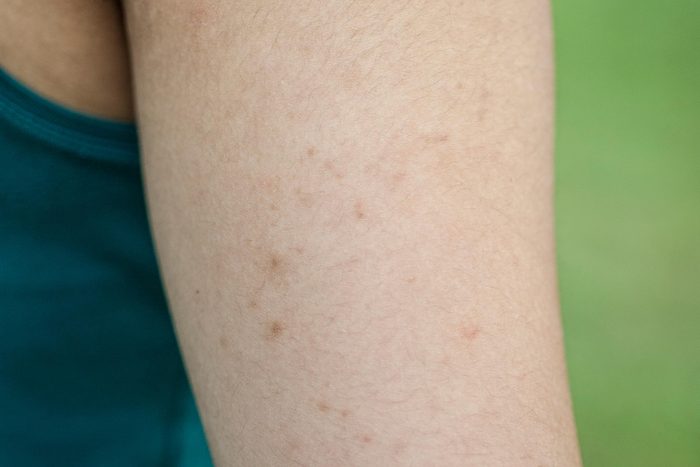
Understanding keratosis pilaris
Keratosis pilaris (KP), sometimes called “chicken skin,” is a common, harmless, genetic condition that causes dry, rough patches of skin and tiny bumps, most often on the back of the arms. “Skin feels like ‘chicken skin’ or sandpaper, and it is oftentimes mistaken for small pimples,” says Samer Jaber, MD, assistant clinical professor of dermatology at the Icahn School of Medicine at Mount Sinai and founder of Washington Square Dermatology. “It can also affect the thighs and buttocks of adults and cheeks of young children.” More than 50 percent of all children and teenagers and 40 percent of all adults have some degree of KP, so if you’ve experienced it, you’re certainly not alone. Keratosis pilaris is thought to occur from an excessive buildup of keratin around hair follicles, which may trap and prevent them from reaching the surface, causing bumps on the skin. “Unfortunately, there is no cure for KP, but it usually improves when you reach adulthood, and by our 20s most people will have seen a significant improvement,” Dr. Jaber says. “It’s also better in the summer and worse in the winter when skin is dryer.” (If you’re experiencing seasonal dryness, check out these surprisingly helpful secrets to fighting dry skin.) In the meantime, there are many treatments that can drastically, if not fully, reduce the appearance of KP.
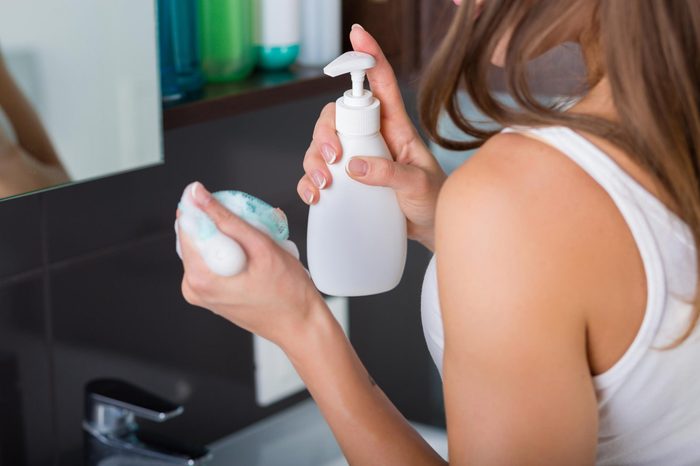
Choose the right cleansers
If keratin is blocking those hair follicles, you’ll need to exfoliate that top layer of dead skin cells to see improvement. “For more moderate to severe cases, moisturizers that exfoliate with ingredients like salicylic acid, glycolic acid, urea, or ammonium lactate can be effective,” Dr. Jaber says. “My personal favourite over-the-counter exfoliating moisturizers are Amlactin and CeraVe-SA. Exfoliation with a loofah in the shower can also be helpful.” (Did you know there’s a difference between dry and dehydrated skin? Here’s how to treat each.)
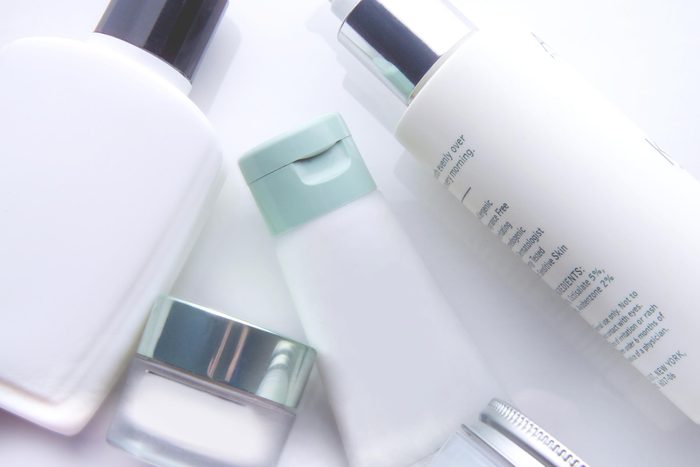
Add topical treatments
The next level of treatment is a topical moisturizer that continues the exfoliation process. A great over-the-counter option recommended by dermatologists is ACGLICOLIC Classic Body Milk by Sesderma, with 10 percent glycolic acid, an alpha-hydroxy acid that thins the stratum corneum, the outermost layer of the epidermis that’s made up of dead cells, plus Boswellic acid, which is anti-allergic, anti-inflammatory, and analgesic. A budget option is Skinfix Renewing Cream, with a natural form of salicylic acid to exfoliate, bisabolol and shea butter to soothe redness, plus jojoba, grapeseed, and sweet almond oils to soften and hydrate rough patches. Another option is to talk to your doctor about a prescription remedy. Dr. Jaber often recommends a combination of a prescription salicylic acid 6 percent cream in the morning, with a topical retinoid cream in the evening. “Topical steroid creams can also be used if the skin is red and itchy,” says Dr. Jaber. Retinoid creams prevent dead cells from clogging pores, treat oil production, nix bacteria that causes breakouts, and calm inflammation. Don’t miss these signs your body is aging faster than you are.
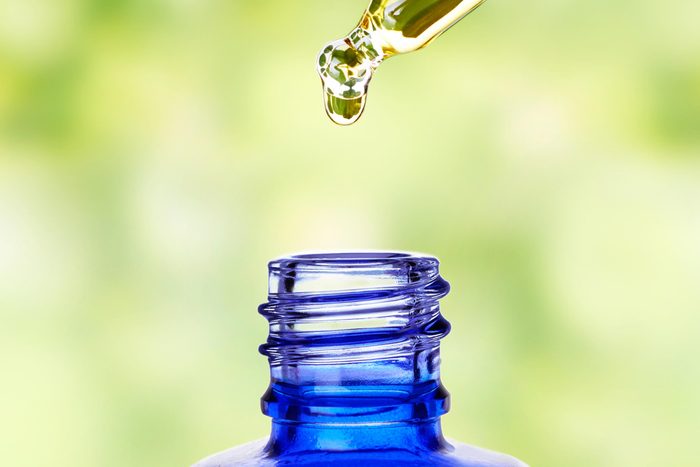
Try out a pro peel
A professional peel, which is more powerful than any topical treatments, can kick-start major healing. Dr. Jaber recommends 20 to 30 percent glycolic acid peels, which damage skin in a controlled manner. By using chemicals to cause tissue death, glycolic acid peels essentially get rid of your old bumpy skin and then, by creating a superficial wound, stimulate your body’s natural healing process. As your new skin grows, you are likely to see improved appearance and texture. Find out more about getting a chemical peel.
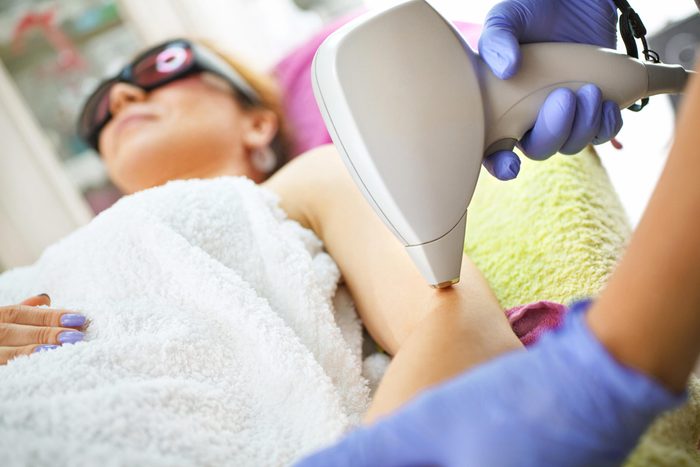
Get laser hair removal
If there’s a lot of thick hair in the affected areas, laser hair removal might help, according to Dr. Jaber. Intense Pulsed Light (IPL) lasers are typically used to remove hair at the follicle level, but by stripping your skin of pore-blocking keratin, laser hair removal can also improve KP. In one study, published in the JAMA Dermatology, keratosis pilaris patients who underwent laser treatment on one arm, and dermatologists, who did not know which arm of the patient received treatment, reported significant improvements in skin texture and bumpiness. These are the other powerful benefits of laser treatment therapy.

To reduce redness, try pulsed-dye lasers
If your keratosis pilaris is also splotched with red pigment that bothers you, consider going in for pulsed-dye lasers. These lasers emit short bursts of concentrated, high-intensity yellow light to destroy targeted tissue. The light kills the blood vessels but leaves surrounding skin undamaged, meaning this treatment is safe and won’t lead to long-term skin damage, though it does require multiple treatments. In one study published in Pediatric Dermatology, all participants with keratosis pilaris reported a marked improvement in their skin after pulsed-dye laser treatments. From cysts to ingrown hairs, here are 11 other skin mysteries explained.
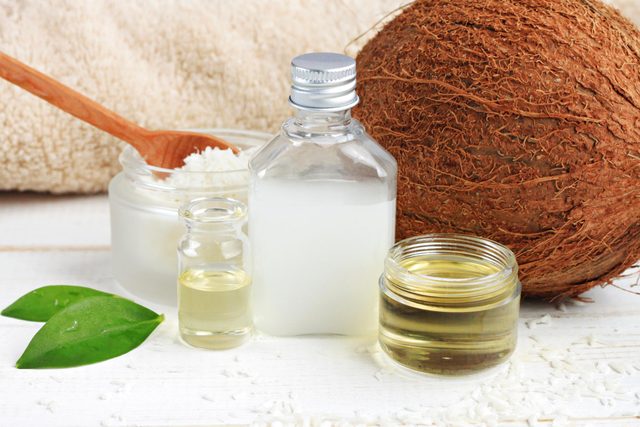
Go the natural route
If you prefer treating your body with entirely natural methods, coconut oil has been found to noticeably reduce the appearance of KP, says Heather Rogers, MD, a dermatologist at Modern Dermatology in Seattle. (Here’s how to make your own coconut oil moisturizer.) This treatment is perfect for anyone who wants to start their treatment immediately since you probably already have this ingredient in your kitchen. Coconut oil has anti-inflammatory properties, hydrates dry skin, soothes itching, and contains healthy vitamins.
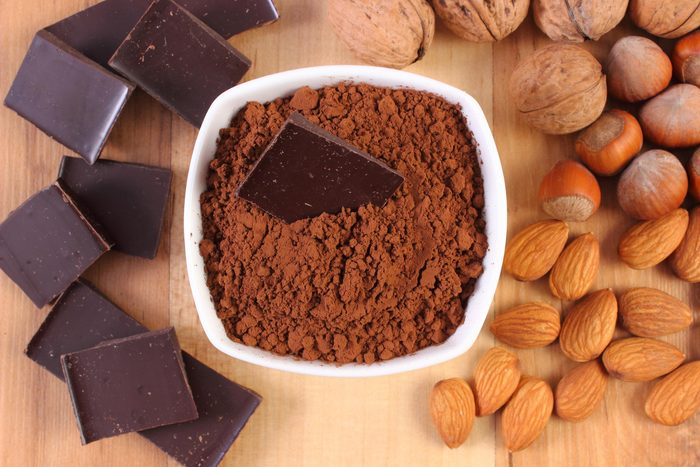
Adjust your diet
A great way to begin healing your body of any ailment is to make healthy lifestyle changes. Zinc, in particular, can help keep skin healthy, says Jennifer Herrmann, MD, a dermatologist at Moy Fincher Chips Facial Plastics + Dermatology in Beverly Hills, California. Good sources of zinc include oysters, beef, lamb, chicken, pumpkin seeds, spinach, chickpeas, coconut, spirulina, cashews, sunflower seeds, beans, tempeh, and dark chocolate/cacao. Magnesium—found in whole wheat, spinach, nuts, quinoa, dark chocolate, and black beans—may help as well. Next, find out 12 things dermatologists do in the winter that you don’t.
